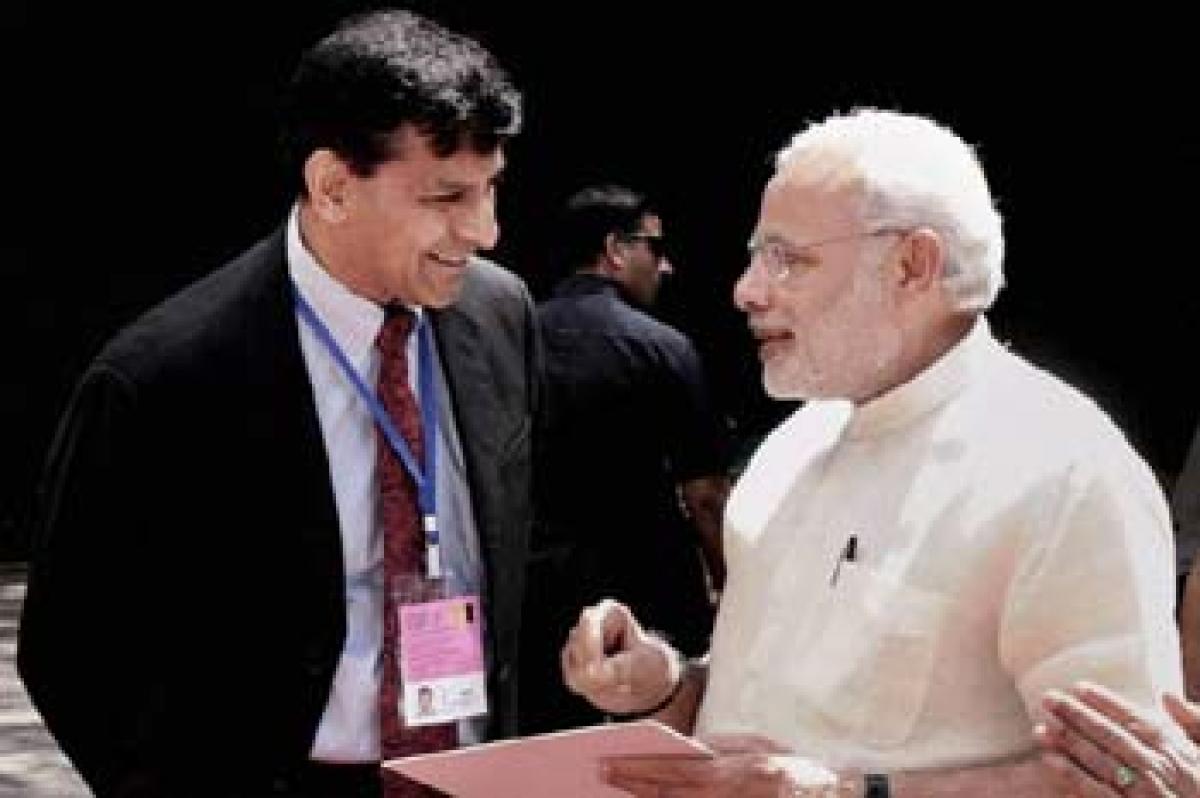Live
- 3 held, 810 kg ganja seized
- Workshop on ‘Live Agri-technologies’ concludes at SPMVV
- Advancing Biomedical Research with NMR techniques
- Key Highlights of India in 2024
- Expose Opposition’s evil propaganda in villages: Seethakka to Cong workers
- MLA Sudhir focuses on amenities at Srikalahasti rly station
- Chittoor police crack down on drunk driving with 963 cases
- Vision document historical, says Keshav
- YSRCP to boycott elections to WUAs
- Farmers led by YSRCP leaders stage protest against graft
Just In

In late 2014, the knives were out for RBI Governor Raghuram Rajan. Finance ministry officials were frustrated by his reluctance to cut interest rates to stimulate growth, and moves were afoot to ease him out of the job. Some were airing their reservations about Rajan\'s hawkish stance in the media.
New Delhi : In late 2014, the knives were out for RBI Governor Raghuram Rajan. Finance ministry officials were frustrated by his reluctance to cut interest rates to stimulate growth, and moves were afoot to ease him out of the job. Some were airing their reservations about Rajan's hawkish stance in the media.
Prime Minister Narendra Modi convened a meeting of senior finance ministry staff that December to hear their complaints, said a person who was present. At the end, the leader delivered a stern message: do not indulge in a public spat with the central bank.
The moment marked a turning point in ties between the heads of the newly installed government and the Reserve Bank of India (RBI). Since then, Modi and Rajan have developed a close working rapport, government officials and people close to the governor say, and that could be crucial to the $2 trillion economy.
With Modi's patronage, it is more likely the government will reappoint Rajan, whose three-year term expires in September, should he wish to stay on, the sources said. That would allow him to try to revive India's banking sector that has been smothered by distressed debt, which, in turn, is choking off economic recovery.
"Rajan will get another term and he will accept it," said Arvind Mayaram, India's former Finance Secretary who Rajan worked with closely first as the government's chief economic adviser and then as RBI Governor. "He is well entrenched in India's political economy."
A top government official said the decision rests with Modi and the leader has not yet said what he wants to do. The Prime Minister's office and finance ministry did not respond to requests for comment. Rajan, former Chief Mconomist at the International Monetary Fund, has not disclosed his plans, and did not respond to requests for comment for this article.
Modi's support is key
Modi's support would be important if the 53-year-old RBI chief is to get the big state banking sector to complete a cleanup of massive debts and force defaulters to pay up. Banks making provisions for bad debt are reluctant to issue new loans, leading to criticism within the sector and complaints from smaller businesses and politicians.
Patronage from above will also help shield Rajan from lingering opposition within the ruling nationalist Bharatiya Janata Party (BJP). BJP parliamentarian and economist Subramanian Swamy, one of those leading a campaign to remove Rajan, recently accused him of "wilfully and deliberately wrecking the Indian economy."
The Governor's penchant for blunt commentary raises hackles. Rajan's appeal for tolerance late last year was perceived to be a veiled criticism of the government for appealing to the Hindu majority at the expense of minority communities, prompting Swamy to rebuke him for speaking like a "grandfather.”
Rajan recently compared India's fast-growing economy to a "one-eyed king in the land of the blind". Trade Minister Nirmala Sitharaman publicly censured his comments.
Bonhomie
The first signs of growing bonhomie between Modi and Rajan came early last year, when Modi called Rajan the "best teacher" for explaining complex economic issues to him. Days later, the Governor returned the compliment, saying the teaching went both ways. The Prime Minister backed Rajan in the monetary policy panel's composition and blocking moves to strip the RBI authority to regulate government bonds and manage public debt.
Modi's office also directed the Finance Ministry to pursue only those policies where there was agreement with the central bank, a former finance ministry official said. Rajan may prove a more effective Governor second time around if he gets the chance, say some RBI insiders and economists.
Although he fended off a market attack on the rupee early in his tenure, bankers, economists and his former colleagues said he was relatively slow to grasp how liquidity flows through the economy and how to fine-tune it to meet his primary policy goal of taming inflation.
Under Rajan, the RBI forced banks to source limited short-term funds from cash-for-bond auctions rather than getting unlimited funds from the central bank at a fixed rate. Banks complained the new system was forcing up costs and hampering the transmission of rate cuts to the real economy, said several bankers privy to the discussions with the RBI.
At first, Rajan publicly dismissed their concerns as "nonsense". It was only after 16 months of pleading by banks that he finally revamped the RBI's liquidity management in April, the bankers said.
A second stint is likely to see a more accomplished operator as the RBI tackles bank debt, tries to develop the bond market as a viable source of funding for companies and switches to a Western-style approach to decision making. A new monetary policy panel will be formed later this year to set interest rates, something Rajan favoured to make the RBI more independent and introduce transparency to the process.
By Rajesh Kumar Singh

© 2024 Hyderabad Media House Limited/The Hans India. All rights reserved. Powered by hocalwire.com







